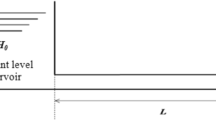Abstract
Understanding water hammer is very important to the prevention of excessive pressure build-up in pipelines. Many researchers have studied this phenomenon, drawing effective solutions through the time- and frequency-domain approaches. For the purposes of enhancing the advantages of the frequency-domain approach and, thereby, rendering investigations of the dynamic characteristics of pipelines more effective, we propose partial fraction expansion of the transfer function between the unsteady flow source and a given section. We simulate the proposed approach using a vibration element inserted into a simple pipeline, deducing much useful physical information pertaining to pipeline design. We conclude that locating the resonance of the vibration element between the first and second resonances of the pipeline can mitigate the excessive pressure build-up attendant on the occurrence of water hammer. Our method of partial fraction expansion is expected to be useful and effective in analyses of unsteady flows in pipelines.
Similar content being viewed by others
References
V. L. Streeter and E. B. Wylie, Hydraulic transients, McGraw-Hill, New York, USA (1967).
E. B. Wylie and V. L. Streeter, Fluid transient in systems, Prentice Hall Inc., Englewood Cliffs, N. J. (1993).
L. Suo and E. B. Wylie, Impulse response method for frequency-dependent pipeline transients, Journal of Fluids Engineering, 111(4) (1989) 478–483.
S. H. Kim, Design of surge tank for water supply systems using the impulse response method with the GA algorithm, Journal of Mechanical Science and Technology, 24(2) (2010) 629–638.
B. Brunone and M. Ferrante, Detecting leaks in pressurized pipes by means of transient, J. Hydraul. Res. 39(5) (2001) 539–547.
W. Mpesha M. H. Chaudhry, and Gassman S, Leak detection in pipes by frequency response method using a step excitation, J. Hydraul. Res. 40(1) (2002) 55–62.
M. Ferrante and B. Brunone, Pipe system diagnosis and leak detection by unsteady-state tests-1: harmonic analysis, Adv. Water Resour. 26 (2002) 95–105.
P. M. Morese and K. U. Ingard, Theoretical Acoustics (Chap. 7), McGraw-Hill, New York, USA (1968).
L. E. Kinsler et al., Fundamentals of Acoustics (Chap. 5), John Wiley & Sons, New York, USA (1982).
M. L. Munsal, Acoustics of Ducts and Mufflers (Chap. 1), John Wiley & Sons, New York, USA (1987).
Author information
Authors and Affiliations
Corresponding author
Additional information
This paper was recommended for publication in revised form by Associate Editor Yeon June Kang
Jun-Shin Lee received his Ph. D. degree from the Mechanical Engineering Department of KAIST in 1995. He is currently a principal researcher in the Green-Growth Laboratory of the Research Institute in the Korea Electric Power Corporation, Daejeon, Korea. His research interests are the vibration control of pipelines built in nuclear power plants and development of predictive monitoring algorithms for wind turbines.
Bong-Ki Kim received his Ph. D. degree in 1997 from the Department of Mechanical Engineering of KAIST. He was a research engineer in the NVH department at the Samsung Motors Technology Center from 1997 to 1998. From 1999 to 2000, he worked at Arvin-Meritor Exhaust in the USA as a research engineer. Since 2000, he has been working with the acoustics research group of KIMM. His research interests include sound field visualization and noise/vibration control.
Wook-Ryun Lee received his Master’s degree in Mechanical Engineering from Chungnam National University in 2004. He is currently a senior researcher in the Power Generation Laboratory of the Research Institute of the Korea Electric Power Corporation, Daejeon, Korea. His research interests are control of noise and vibration generated from power plants, and electrical energy storage using superconducting flywheels.
Ki-Yong Oh received his Master’s degree in Mechanical Engineering Department from KAIST in 2006. He is currently a researcher in the Green-Growth Laboratory of the Research Institute of the Korea Electric Power Corporation, Daejeon, Korea. His research interests include active control of vibration and wind turbine design.
Rights and permissions
About this article
Cite this article
Lee, JS., Kim, BK., Lee, WR. et al. Analysis of water hammer in pipelines by partial fraction expansion of transfer function in frequency domain. J Mech Sci Technol 24, 1975–1980 (2010). https://doi.org/10.1007/s12206-010-0708-6
Received:
Revised:
Accepted:
Published:
Issue Date:
DOI: https://doi.org/10.1007/s12206-010-0708-6




